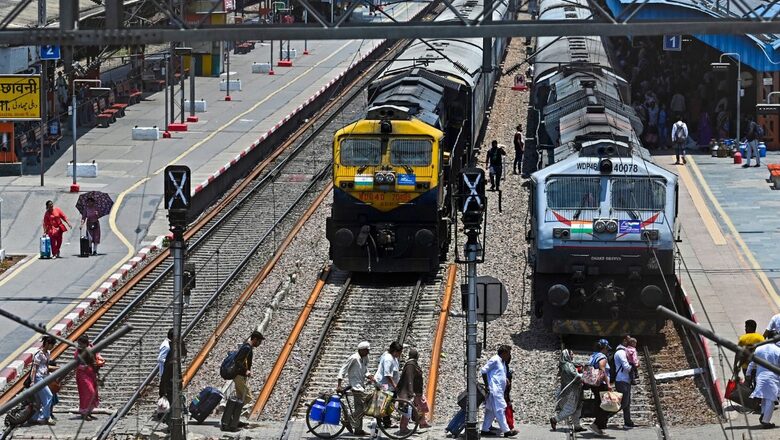
views
A wave of indignation swept through the nation recently, when 295 people lost their lives in a devastating incident due to train collision near Balasore, Odisha. The accident invited scathing criticism of the government’s policy on railway safety. Union Railway Minister Ashwini Vaishnaw led the rescue, relief and resumption of services operation by camping on the site for 51 hours. He thus salvaged not only the image of the government but also his own political career. The Commission of Railway Safety, a statutory body, inquired into the accident. The government has notified a probe by the CBI, to allay apprehensions of sabotage.
The Modi government has created a precedent of sorts with the railway minister holding additional portfolios. At one time, Piyush Goyal held the portfolios of Railway, Coal in addition to Consumer Affairs and Public Distribution. Thus, apart from the Railways, Vaishnaw also holds the portfolios of Communication and Electronics & Information Technologies. The railway minister in India always wears a crown of thorns. However, in this case, it is easy to imagine the workload on his head as well.
A fortnight after the Balasore tragedy, this columnist received the news of the death of an acquaintance on the railway track in West Bengal. The man, who was feeling ill, accidentally fell to his death from the local train on the Howrah-Burdwan main line. This caused a temporary disruption of services on the line. The railway had to make special arrangements to retrieve his severely mutilated body from the track.
What of one death, one might think, against so many in Balasore. The reality is actually the other way round. The National Crime Records Bureau’s (NCRB) figures show that a disproportionately larger number of people perish in these non-consequential train accidents. These accidents fall in the ‘excluded category’ even for the Commission of Railway Safety, which functions under the Ministry of Civil Aviation. The number of consequential railway accidents has fallen appreciably in the last two decades, more particularly in the last nine years of the Modi government. According to a figure given by Ashwini Vaishnaw to Lok Sabha recently, the number has declined from 135 in FY 2014-15 to 48 in FY 2022-23. At the turn of the century, the number was 473 (FY 2000-01). While the average number of consequential train accidents in the decennial period 2004-14 was 171 per annum, it plummeted to 71 per annum in 2014-23.
The declining numbers could be attributed to a slew of safety measures adopted by the government in the last nine years. The most talked about is Kavach, which has been adopted as Automatic Train Protection System (ATS), on which the government has already spent around Rs 352 crore. The nomenclature misled the Opposition, who thought it would act as a shield between two trains colliding head-on. The Balasore train tragedy, according to the railway minister, was not related to Kavach in any way. Kavach only aids a loco pilot in train running within specified speed limits, by automatic application of brakes, if the loco pilot fails to do so or fails to apply brakes at the red signal.
A large number of people die of either falling from a train or colliding with a train on track. As per the Accidental Deaths and Suicide in India, 2021 (published by NCRB, Ministry of Home Affairs), they constituted 67.2 percent of fatalities in railway-related accidents. In absolute terms, the figure was 11,036. Deaths in explosions, fire and other incidents on board (5287) contributed 32.2 percent of fatalities. Deaths due to train collisions (86) were merely 0.5 percent, whereas derailment deaths (22) constituted meagre 0.1 percent (ADAS, 2021, P.130). The figures from 2019, pre-Covid year, show that falling from a train or colliding with a moving train claimed 18,339 lives constituting 74.49 percent of fatalities (Accidental Deaths and Suicide in India, 2019, P.128).
It is easy to see that Indian Railways (IR) is not responsible, at least directly, for these incidents. It is the callousness of commuters that causes such a large number of accidents in this category. The unmanned level crossings have conventionally been danger zone, due to the carelessness of its users rather than the loco pilots. In 2019, the government decided to do away with all unmanned level crossings. As on April 1, 2022, there were only 755 unmanned level crossings left in the country, constituting a mere 3.9 percent, as against 18,746 manned level crossings (Indian Railways Year Book 2021-22, P.59).
The Modi government has apparently done more than any previous government to ensure railway safety. Still, the shocking figures of fatalities due to fall or collisions with moving trains in Accidental Deaths and Suicide in India year on year reveal a gory picture. They are too large to be left unattended due to technical reasons. It has become obligatory for the government to inquire into such incidents as a whole, fix the dark spots, and educate commuters on safety practices.
The writer is author of the book “The Microphone Men: How Orators Created a Modern India” (2019) and an independent researcher based in New Delhi. Views expressed in the above piece are personal and solely that of the author. They do not necessarily reflect News18’s views.




















Comments
0 comment